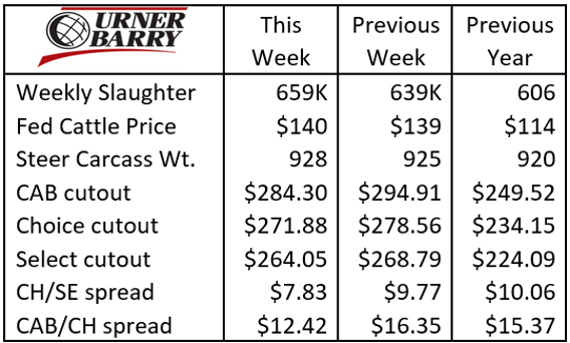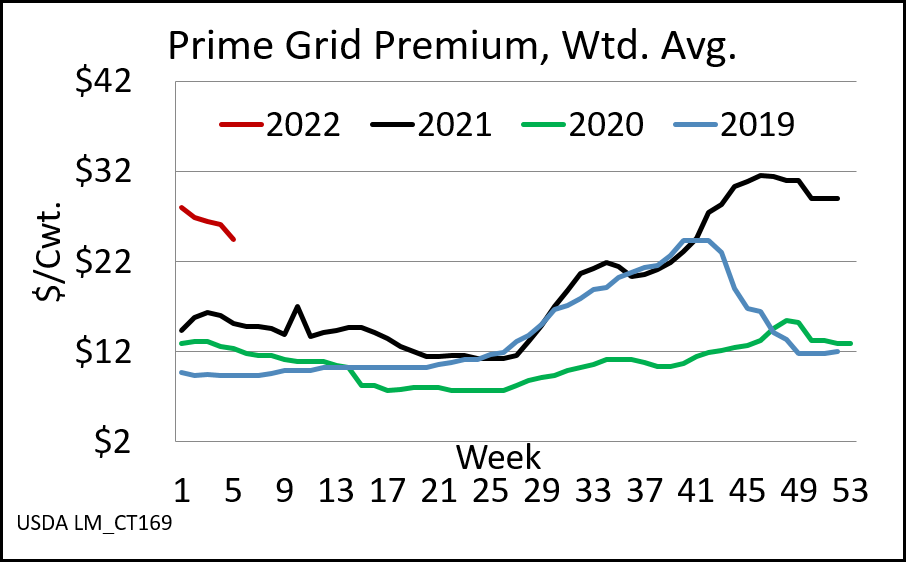CAB Insider: Prime Grade Prompts Attention

The slaughter pace last week was the best we’ve seen in 2022, with an estimated Federally Inspected total of 659K. Daily steer/heifer head counts Monday through Thursday were 96K, 94K, 93K and 94K head per day respectively, along the lines of 1K to 2K improvements over the daily pace the week prior. Given the previous week’s disappointing pace due to weather-related issues in Texas, these are very promising daily totals.
Fed steers and heifers sold higher last week in a range of +$2 in the northern feeding region, to +$1 in the south. This put the top end of the market around $143/cwt. in Iowa/Minnesota, and the southern highs at $140/cwt. in Kansas and Texas, as of Thursday afternoon.
The market was led higher by the futures, apparently, as nothing fundamentally about the boxed beef market prompted higher priced cattle. February Live Cattle futures trended higher Monday through Thursday, but by midday Friday the contract had retraced all of those gains, back down to the week’s starting point at $141.80/cwt. All in all, futures prices continue to trend in a positive direction across the long-term horizon.

Carcass weights are back on the rise, with the most recent 928 lb. steer carcass weight reaching back up to touch the early Jan. high. Despite some true winter weather in the northeast and southern feeding regions, there is a vast area of dry and temperate conditions in the high plains with good conditions that continues to push weights higher. Additionally, in the month of Jan. we failed to harvest about 100K head of cattle that “could have” been slaughtered, had labor issues not plagued the industry again with further COVID ramifications.
The wholesale beef market was firmly lower last week with some items touching 52-week price lows. The most valuable middle meat cuts, ribeyes and tenderloins, led the downward price decline. CAB brand tenderloins have declined from $14.50/lb. in mid-January to last week’s $11.80/lb. market average, the most dramatic decline in that period since 2007. The difference, of course, is the record-high recent Jan. price prior to the drop. Strip loins and top butts are on an increasing price trend and will likely only see a brief pullback as we move toward the spring demand period.
Economic inflation continues to be a headline and concerning to the beef marketplace. However, if weekly slaughter numbers continue to show the kind of improvement seen last week then there is hope for beef end users that larger production can support lower wholesale prices.
Production volume and premiums for Prime grade carcasses have been interesting and telling of demand in the past few years. We’ve documented in the CAB Insider that Prime carcasses have earnestly increased in the fed cattle supply since 2013, moving from 3% to 10% of the carcass mix for the past two years.
Fed cattle carcass weights are currently plotting record highs for the month of Feb. However, fed cattle slaughter has been down 4.7% to start the year. This, alongside the fact that the Prime quality grade is slightly lower than a year ago (9.3% vs. 10.1%) has generated a 12% decline in Prime carcasses in 2022. The drop is not small, but still registers as the second largest weekly Jan. Prime carcass total to date.
Flipping the discussion toward grid premiums for Prime brings the issue into a different light. Price spreads between quality grades have been narrowing quickly from late Jan. to today. That is unquestionably a seasonal tendency, as consumers shift to an end meat roast demand and away from higher-priced middle meats.

The Prime grid premium has narrowed from its Dec. seasonal high of $31.51/cwt. to the last reported $24.50/cwt. The narrowing price spreads are not what’s notable in the current timeline; rather, it’s the combined factors of nearly record-large Prime carcass tonnage coinciding with record-large Prime grid premiums, relative to the Choice price.
Prime cutout values and grid premiums have been rich in the third and fourth quarters of the past two years. Yet the spillover into the first quarter this year shows that the market is reacting to the recently smaller availability, retreating back to the 2019 supply pace.
The spring beef market is just ahead and there’s much to be revealed regarding the supply side of the market. Demand promises to be in line with expectations, even as we’re seeing the currently narrowing price spreads. Larger weekly slaughter volumes may tamp down the quality spreads, but in the meantime the production sector is seeing a sizeable carrot for the highest quality cattle and carcasses.








